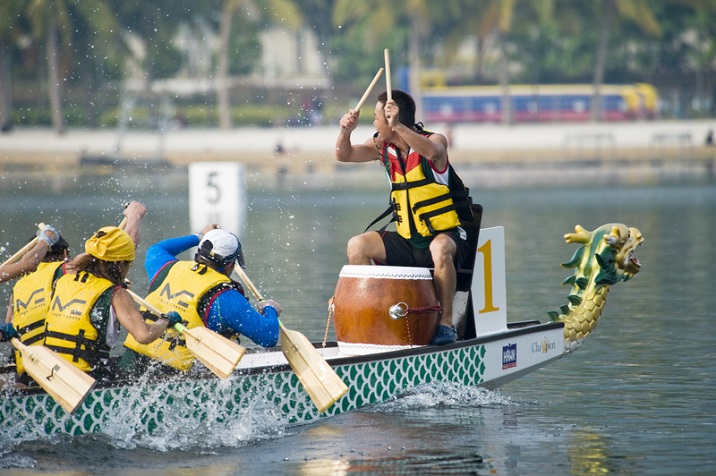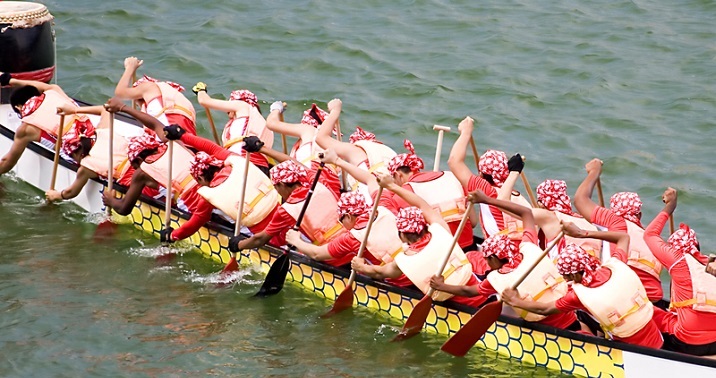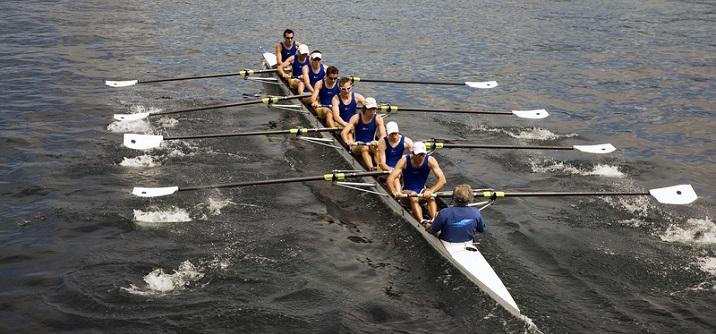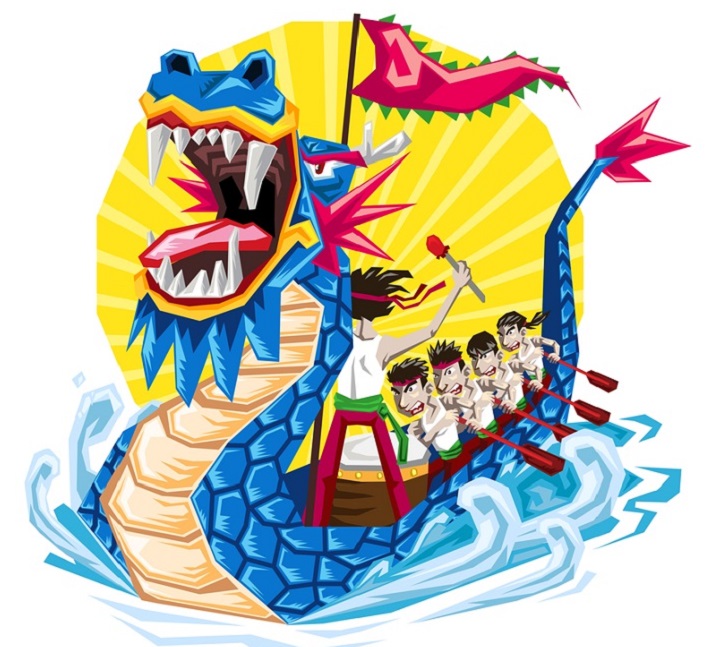
Dragon Boating - Quick Guide
Dragon Boating - Overview
Dragon boat racing is one of the most popular sports in the world. Though the origin of the sport is in Asian countries, many Non-Asian countries are also taking interest in this sport. From a study report it has been found that in China, 250,000 people gather to enjoy the dragon boat racing every year. Out of which 50,000 people come to see from the practise time itself.
This is not a race of individuals; rather it is teamwork where a large group of people generally between 20 and 50 sail a boat by paddling. Similarly other teams also participate in the race. The team whose boats dragon nose touches the finishing line is declared as winner. Both men and women can participate in this sport.

A Brief History of Dragon Boating
China is the origin of this sport. Though many legends have their contributions in developing this sport, but this sport is believed to be originated due to one person named as Chu Yuan. He was an honest advisor to a Chinese emperor but he was banished from the kingdom because of jealousy of other ministers of the kingdom. With regret, he tied himself around an enormous rock and threw himself into the water. People with boats kept on searching his body but it was said that he was devoured by a monster.
Participating Countries
Dragon Boat Racing comes is conducted in water. Since its inception, the popularity of this sport grew exponentially in many regions. Many Asian and non- Asian countries have their active participation in this sport. Countries like USA, China, Hong Kong, New Zealand, South Africa, Canada, and Malaysia have dominating effect upon other countries in this sport. The countries that have organised the championships for this sport are Canada, Hungary, USA, Chez Republic, and Australia.
Dragon Boating - Equipment
In this chapter, we will discuss about the equipment used in Dragon Boating.
Boats
The boat used in this sport has paddling arrangement. There are small boats in which 10 people can paddle and along with it there are bigger boats where at a time 40 people can accommodate.
Most of the international matches use Hong Kong style dragon boats because these are very low to water. Its bearing capacity is 20. The construction material for the boat is teak wood.

Many boats compete on the water at the same time. So, proper team coordination and balancing upon your boat are required to avoid your boat from getting banged to your neighbours. Now days Swift racing boats from China are also being used widely. This is because these types of boats are very fast and sleek.
In rose festival, Dragon boat races in Portland are organised in which another type of boat is used popularly known as Taiwanese Ceremonial Boat. The seats of this type of boat are very wide and heavy too. Incorporation of tail and head of the dragon has been done in this boat. At the finishing line, a flag catcher sitting on the dragon head swings the flag to signal the reach of end line.
The following table lists some commonly used terms in gravitational dragon boats and their significance −
| Terms | Significance |
|---|---|
| Port | Left |
| Starboard | Right |
| Stern | Back |
| Freeboard | Distance between water and gunnels |
| Gunwales | Sides of the boat |
| Bow | Front |
| Centreboard | Stabilizing board connected along the length of the board. |
| Dressing | A way of attaching dragons head and tail to the boat. Without these, the boat is said to be undressed. |
Dragon Boating - Personnel
Caller/Drummer
A small and light weighted person but having a loud voice is appointed in this position. The man in this position calls for the race of the team. The responsibility is to beat the drums for paddling and simultaneously encouraging the team. By working together with tiller, the caller makes sure that the boat is running smoothly.

Lead Strokes
The pair of paddlers that is positioned first in the boat is known as Lead strokes. The person sitting over there is responsible in setting up the pace of the boat that will be followed by rest of the members of the boat.

Lighter Paddlers
Lighter Paddlers will be there with a quality of great timing and team coordination.
Crew
All the paddlers on the boat are crews by default. Categorization of paddlers is done on the basis of power and timing as it is very important and people having good timings are placed at first. With good effort by the crews, the boat sails smoothly in the water.

Captain
Captain is the in-charge of the whole race. Team selects the captain to lead them under pressure. Captain is a member of the crew and he/she will do all the important works like getting passes, attending all meetings etc. In case of any dispute, only captain will resolve the issue by consulting with the officials.
Steer Person
For the safety of the crew members, steer person is 100% responsible. He can get the best view of obstruction while being in the water and instruct the crew members accordingly. He should also possess the knowledge of wind behaviour upon boat sailing. Whatever may be the wind conditions, his/her work is to bring the boat in line.
Coach
Although it is not a mandatory post but is necessary for guidance. He also has the responsibility as a trainer and instructor. Various tasks of a coach includes setting up the positions for different crews, making the strategy, and more important keeping the whole team motivated till the end of the race. A coach can work himself as a paddler on the boat or can be with the team only during the training session.
Manager
A manager arranges all the official meetings. He is also responsible to cater to all the demands made by the crew members pertaining to the race. He/she is also the head of the cheerleader.
Dragon Boating - Stroke Techniques
In this chapter, we will discuss the playing techniques used in Dragon Boating. Before you learn the various stroking techniques, position yourself firmly on the boat. Firmly pin to the side of the boat. Keep your back straight and slightly lean forward and outward. Brace your outboard foot on the foot hold present on the floor. Learning it early is wise because with more improvement, you can use your whole body to paddle it. To grasp the paddle, keep your inside hand on the paddle and your outside hand on the shaft.
There are six basic elements of the stroke and they are −
- Reach
- Catch
- Drive
- Pull
- Recovery
- Rotation
Lets discuss each of these basic elements in a bit more detail.
Reach
This position is also known as Paddles Up position. Length of the stroke is determined by this position. If the length is more then it indicates that more water is pulled. This is basically an extended position where paddle is few inches above the water level before driving the boat into the water.

Forward extension of the outside shoulder should be done and should also be dropped slightly. Just like punching in karate, your outside arm should be straight. When the paddle enters the water, the torso is twisted forward. While doing so the natural unwinding action of the torso may lift up your seat. Bottom arm is extended to straight forward positioned being parallel to the water. Locking at the elbow should be done for the lower arm. The position of your top hand should be about at the height of your forehead and should be outside the boat.
Catch
In this position, the paddle first crushes into the water. Before this position, there is a slight pause during the time of stroke. Main purpose of this pause is to set the timing of the boat. Always remember that entering and exiting of all the paddle blades should be done simultaneously. Simultaneous coordination and team work must be done in such a manner that with less effort more work will be done. During the catching period the angle made by the blade should be 45 degree. Position your outside hand under the arm of the person sitting in front of you.

Drive
The main purpose of this position is to set the blade into the water. Till the time the paddle is not fully immersed inside the water, you have to drive the paddle with both hands up to 18 inches deep inside the water. As huge force is required you need to drive the paddle like hammering it into the concrete. After complete immersion, the paddle will anchor itself in the water. Maintain the anchor in such a manner that it will be easy for you to pull it again up. For maximum bite, the angle made by the blade with the side of the boat should be 90 degree
Pull
Once the paddle is completely inside the water, next step is to move the water. This is known as pull. Pulling back of the paddle should be done in parallel to the boat. The work of the top arm is to stabilize the paddle whereas bottom arm and back muscles do the work of pulling back. While pulling, the paddler should sit back and drive the paddle in the downward direction with the top hand. To impact heavy force, one should rely more upon the back muscles, shoulder, and trunk rather than depending upon the muscle powers. Try not to pull over much back or not to push too much. The total length of pull phase is 18 inch.
Recovery/Exit
At the end of the stroke, the exit of the paddle should be done at the hip level. If the stroke goes past the hip, then it will result in positioning the paddling blade in such a manner that it will slow down the boat. To clear the water with the help of the paddle, you should slightly bend your outside arm. In order to aid the process slightly, twist your lower wrist. As soon as the paddle comes out of the water, it is ready to be pushed again. This recovery stage is important because this will help in giving rest to your muscles and to regain back your strength.
Rotate
One of the major components of the stroke is rotation that helps in attaining maximum extension. With the help of rotation, a paddler can get 2-4 inches extra with every stroke. On an average count, if 20 people will impose the rotational force simultaneously then it can add up to 7 feet to the stroke. Try to impose the rotational force in smooth and elastic manner.
Now lets know about some important paddling commands that you will hear frequently from captain.
| S.No. | Commands & Meaning |
|---|---|
| 1 |
Seat steady By making an angle of 90 degree with the side of the boat, paddle in a relaxed position parallel over the water |
| 2 |
Push off Push your boat away from any obstacles; usually the docks. |
| 3 |
Let it run Crew people stop paddling and the boat comes into the halt naturally. |
| 4 |
Back it down Paddle backward in slow motion |
| 5 |
Draw To move the boat either to the left or to the right. By reaching to the side, pull the water towards the boat. |
| 6 |
Take it away It is a command usually given to start the paddling. |
| 7 |
Paddles up Paddling is done above the water level and ready to start the stroke; usually during the starting of the match. |
| 8 |
Brace the boat It is a command to stabilize your boat by resting the blade on the top of the water. |
| 9 |
Hold the boat It is a command in which resistance force is created with the help of paddles to stop the boat. |
Dragon Boating - Rules and Regulations
All the rules and regulations of dragon boating is governed by International Dragon Boat Federation (IDBF). However, each country has its own governing body too who acts under IDBF. For example, the governing body for US is USDBF (United States Dragon Boat Federation). With slightest difference most of the governing bodies have some common rules. Lets know about some common rules and regulations.
Fees and waivers
This is one of the most important in every dragon boat race because this money is used to protect the people playing this sport. In addition, this money is used for their insurance purpose too. Every participating person needs to sign a legal paper that they are playing this sport with their will. Fees generally vary from few hundred dollars to thousand dollars per event.
Marshalling
The marshalling area is nearby the dock and a marshalling officer is present over there each time. Only the team members who are going to play the sport and their corresponding team manager are allowed in the marshalling area. Counting of all the crew members is done at this place.

Boats
Boats are selected by the board members previously and the crew members need to use the boat provided to them. Before leaving the dock, any defects in the boat should be notified to the officials. Position of drums and steering should be checked properly. Boats are weighed in advance to make sure that it is in accordance with the prescribed level.
Etiquette
While paddling out to the race course, try to maintain sufficient distance from the race course. In case another race is going on at the same time, wait for the other race to complete. It is not a good sportsman spirit to comment on other boat members while passing by them. In the eye of IDBF law, commenting on other crew members is not tolerable.
Dragon Boating - Championships
International Dragon Boat Federation is the governing body of this race competition. Every participating country has its own governing body to organize the race successfully throughout a calendar year.

Here is a list of some important tournaments in Dragon Boating held across the globe −
- IDBF Championships
- IDBF World Cup
- Canadian Dragon Boat Championships
- Stanley International Dragon Boat Championship
- European Federation Dragon Boat Championships
- ICF Dragon Boat World Championship